Metro Awakening VR delivers some terrifying moments in its deep, thought-provoking story, but after a strong start, repetitive levels and pacing issues kill most of its momentum.
Based on its first few hours, Metro Awakening could be considered quite the challenger to Half-Life: Alyx‘s VR crown. The first thing you see once the game starts proper is a small room bursting at the seams with interactive physics objects that can be picked up, inspected and thrown at the walls. More than that, though, they can interact with each other – throw a chess piece at the chess board for instance and multiple pieces sat atop it will be knocked over. Drop a heavy book on the keys of the piano in the corner and it will play the exact notes the book landed on. Hell, there’s even a guitar you can pick up and strum – and as far as I remember, even Alyx didn’t have one of those!
Once you leave that room, there’s a small settlement to wander through with a couple of NPCs whose conversations you can earwig on, assuming you”re not impatient to get to the action, that is. That action comes pretty quickly, too – a short set piece involving a booming mounted gun follows, which sees you mowing down waves of surprisingly sprightly Nosalis, before you and a pair of fellow survivors rush to plant a bomb to seal the entrance the beasts are rushing in from.
It’s like the Metro series in a nutshell, a ‘greatest hits’ theme park ride, if you will, and it’s a fantastic opener for both newcomers to the series and long time fans. As the hours go on, though, the cracks start to appear. The number of interactive props start to dwindle, the levels themselves become less imaginative, and its pacing positively drops off a cliff. It soon becomes quite clear that, while there’s a good game somewhere here in Metro Awakening, its best bits are front loaded at the start and, the deeper you get into its metaphorical metro tunnel, the further away they become.
Unlike previous games in the Metro series, which focused on the story of Artyom, in Awakening you play as Serdar, a personable doctor whose cosy (as cosy as it can be in an apocalypse) existence is disrupted when his wife Yana decides to stop taking the antipsychotics he prescribed her. Yana, you see, can hear the voice of her dead son. She’s convinced he’s calling to her from somewhere within the metro, but Serdar, ever the man of science, believes it’s just a hallucination caused by mental illness. This kicks off a story that’ll be familiar to Metro fans – a wonderful mix of sci-fi and Russian superstition that posits questions about what happens after we die, what are ghosts, and could reincarnation actually be a thing?
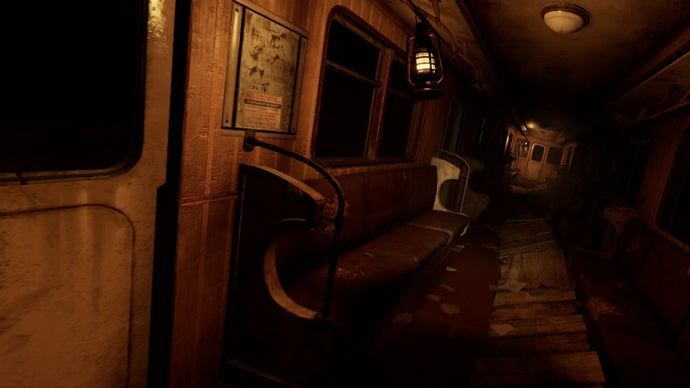
It’s a plot that’s surprisingly deep and touching overall, and there’s a large cast of characters whose lives (and afterlives) are personally affected by Serdar’s actions. However, this also creates a game of two halves in a lot of respects, as its heavy emphasis on story-telling often feels at odds with its immersive, survival horror aspects. Want a game with an excellent philosophical narrative that’s deep and slow-paced? Sure, it’s here, but you’ve got some pretty terrifying and tense stealth sections to get through first if you’re going to see it through to its conclusion, and vice versa. If you want both, perfect, this is absolutely the game for you. But for me, at least, I found that being pulled to and fro between static, ‘people talking at you’ sections and smaller, ‘waves of monsters jump at you from the dark’ areas to be slightly jarring. With a bit more variety, both of these main threads could absolutely work together, but in the end it just makes Awakening a little too predictable.
The set-ups are almost always the same. For example, if someone is talking to you in your ear, that nearly always means you’ve got a long section of walking down corridors to sit through, with maybe the occasional wheel to turn or door to charge up. When no one is talking, chances are you’re about to hit enemy territory. Entering a room with a load of ammo on a table? Wave battle coming up. On and on it goes, and none of it feels as fresh and exciting as a VR game should be.
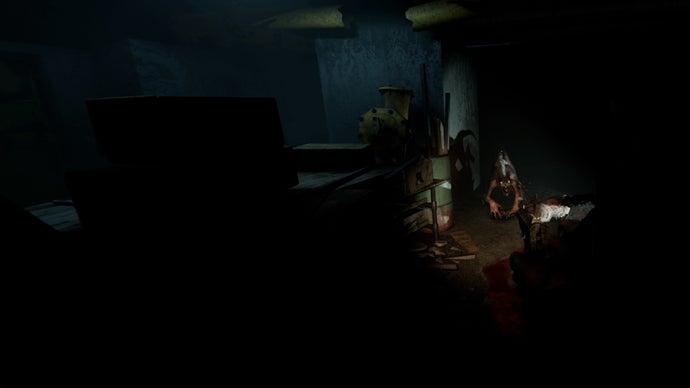
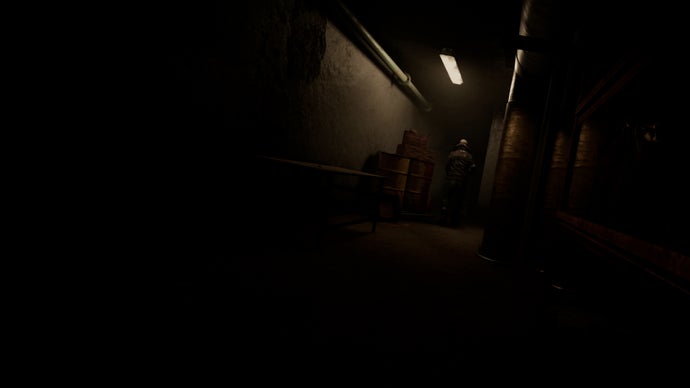
Of course, Awakening is also a Metro game underneath all that, and thankfully, developer Vertigo Games has expertly translated the core Metro experience into virtual reality. The main tool in your subterranean adventures is your backpack, which you will regularly need to pull from either shoulder in order to access your items and weapons. Just like in the flat games, you also need to charge your head torch so you don’t get lost in the darkness. Here, though, rather than squeezing a trigger, you need to wind a crank handle on a small recharging device. You physically put on – and take off – your gas mask too, as you do with the mask’s filters (although the latter is slightly simplified so you don’t need to twist them into place as well). The mask also gets sweaty, and by moving your hand in front of your face you can wipe that off. It’s simple but effective, and adds brilliantly to the immersion – as does lifting your wrist to check your watch and see how much time the filter has left before it runs out.
The four available guns are great, too. They’re wonderfully tactile to reload, as each one has movable slides so you can inspect the interiors and see if there’s a bullet in the chamber. They’re fun to fire, too, as they all have a nice punch to them, and holstering and unholstering them from my body was rarely aggravating. One of my favourite bits of VR immersion, though, came from scavenging an enemy’s remains after a shootout. Wandering around, picking up their guns, taking out the magazines and stashing them in my chest to gather up all available ammo felt cool and satisfymeing, and it gave me the biggest feeling of ‘actually being there’. One big difference between Awakening and the flat Metro games, though, is that there are no vendors in Awakening, so you don’t need to worry about bullets being currency. You just need to worry about them hitting your target.
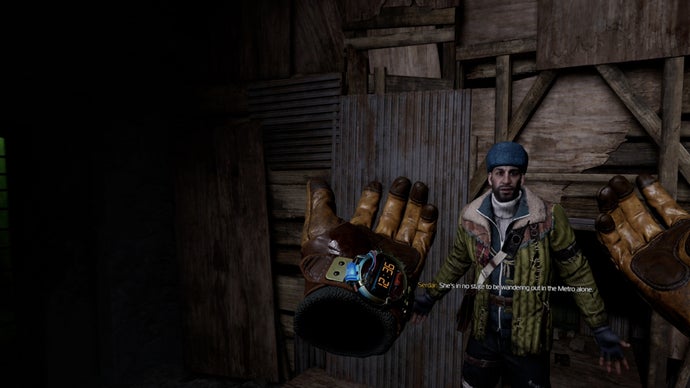
Disappointingly, there are only three monster types in the game, and sadly no big boss fights or epic set pieces, which definitely contributes to that repetitive feeling I mentioned earlier. There are the small, rat-like Lurkers that either attack you individually or in waves; the large, also rat-like Nosalis that mainly attack in packs; and finally some horrible spiders that leap at your face from the walls and ceilings, but only in certain radioactive sections. Each enemy type moves fairly fast in Awakening, which means aiming at and actually hitting them can be fairly tricky, especially if they’re making you jump when they appear.
The spiders are definitely the worst offenders on this front, so much so that in the end I just tried to run past them as nailing kill shots before they jumped onto my mask was almost impossible (and if you don’t have any ammo left, you’re almost better off just reloading a checkpoint). The effect of the spiders crawling on you in VR is, admittedly, quite cool, though – sometimes you’ll lift your hand to find one on the back of your wrist, other times they’ll land on the back of your head and you’ll see their legs poke out into your field of vision. It’s obviously going to be a nightmare for those with arachnophobia, but for me the creepiness died down after it had happened a couple of times.
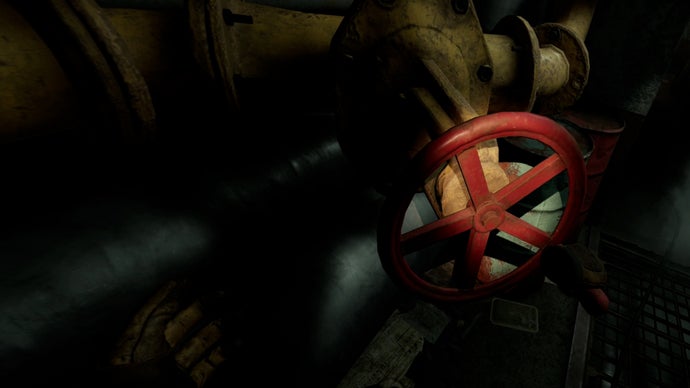
Once that scariness wears off, monster fights ultimately become rather repetitive, and my favourite bits of Awakening ended up being the fights against the human characters. Even though these encounters were reasonably few and far between, you do have a bit more choice and agency in how you approach them – sure, those choices mostly boil down to slowly and stealthily, or going in all guns blazing, but even that little bit of decision-making makes the whole thing feel that much more immersive. With the monsters you’re mainly locked in a small arena, attacked from all sides, but with the humans there’s almost always a little vent to hide in or a box to crouch behind. It felt refreshing to have these (admittedly small) moments of freedom, because otherwise the game is really quite linear and repetitive.
I get that an underground metro system isn’t going to be the most visually interesting of places, but Awakening’s level design and story beats mean that you’ll revisit the same few places over and over again, each time with fewer and fewer things to do in them. For example, there’s a Far Cry 3-style hallucinatory experience at one point, but it’s clear you’re just going along yet another standard tunnel scene the game’s used many times before – only now it’s populated by some floating candles and doors in weird places. In other Metro games, you get to go outside a bit, explore crashed planes and ruined buildings to give you some variety. The more you play Awakening, however, the more you start to realise how its individual building blocks are simply being reskinned to give the illusion of something different. To be fair, these are things that probably wouldn’t have bothered me as much in a flat Metro game. In VR, though, when the world is all around me and I’m right there up in its business, they become a lot more noticeable and it yanks me out of the experience.
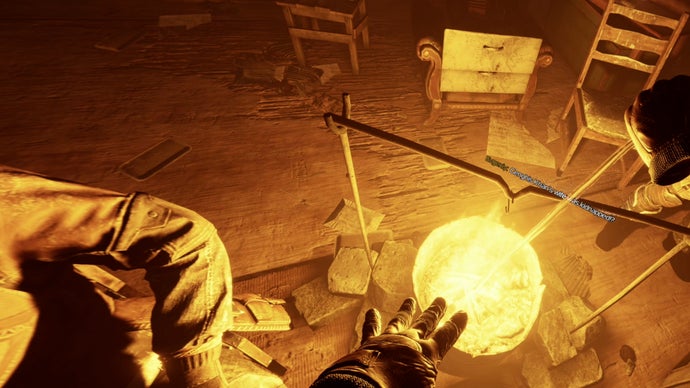
Visually, there’s still a lot to admire here, but character models and facial expressions can often feel a little stiff, and Awakening’s overall sense of detail isn’t as impressive as something like Batman Arkham Shadow, for example. Admittedly, I was playing Metro Awakening on the PSVR2 rather than the Meta Quest 3, but this, too, came with its own problems. Chiefly: the dreaded Mura effect from the PSVR 2’s OLED screens. I hardly ever notice the weird grainy effect of the OLED’s pixels in games that have nice bright graphics like Horizon Call of the Mountain, but in Awakening when everything plays out in a low light, it was impossible to ignore and made things look rather ugly. I’ve since played the first two hours again on PC VR using a connected Quest 3, and with that headset, everything looked spot on. It’s not a game breaker, but if you own both headsets, the Steam build is the one you’ll want to put your face in.
On the subject of game breakers, I ran into a couple of hard crash bugs that came out of nowhere near the end of the game, plus a weird freezing bug that only occurred after pausing the game for a while (such as five minutes or more) and then unpausing it. Other than that, everything was pretty robust and worked well – object interactions were seamless, the sound design was great (and probably one of Awakening’s high points if I’m honest), and there’s a huge number of comfort settings. These include the standard click turns and teleportation movement schemes down to a nice seated mode and the ability to customise things like vignettes and ladder traversal. One option that was missing, however, was the option to play the game in the Russian language, which I liked to do in the other games. Instead, it’s just the English language with some heavy Russian accents put on top.
Overall, I did enjoy playing Metro Awakening, but I’m not sure I’d ever go back to it again (and certainly not just to find its collectible postcards). Its disappointing back half makes it hard to really recommend, too. VR games that constantly surprise and delight are what I’m after – games like Astrobot Rescue Mission, Boneworks, or Batman Arkham Shadow. But after a strong start and a really immersive interpretation of what it feels like to actually ‘be’ down there those grungy, radioactive tunnels, Metro Awakening is ultimately a train that slowly runs out of steam across its eight to nine-hour run time. Rather than rise to the top of the VR pile, Awakening never quite breaks out from the middle of the road.
A copy of Metro Awakening VR was provided for review by developer Vertigo Games.
